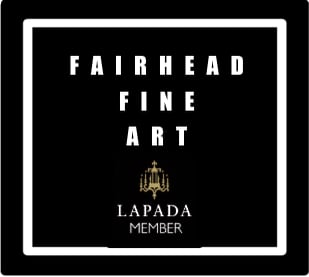Jean Dufy was born in 1888 in Le Havre, France. The brother of artist Raoul Dufy, he was surrounded by art as a child and teen, though he did not pursue an art career until later in life. At age sixteen Dufy left home to work as a clerk for an overseas import business, followed by a position as a secretary on the transatlantic liner "La Savoie," which traveled between New York and Le Havre. While working at these jobs, he attended various art expositions, including one hosted by Cercle de l'Art Moderne in Le Havre featuring artists such as Picasso, Matisse and Derain. He was inspired, and enrolled in art courses at Le Havre's l'Ecole des Beaux Arts for a brief time before relocating to Paris with his brother.
While in Paris Dufy became associated with Cubist painters Picasso and Georges Braque, the latter becoming a mentor to the younger artist. In 1914, Dufy began to exhibit his watercolor paintings at the Berthe Weill Gallery; that same year, he was drafted for military service in World War I as a horse soldier, and he painted many landscape scenes while being stationed throughout France.
When he returned from the war in 1916 Dufy worked briefly with his brother in a Lyon studio doing textile design for Banchini-Ferier. This was followed by what would become his lifelong career, decorating porcelain at the Theodore Haviland studio in Lamages. For his design work on behalf of the studio he received the International Exhibition of Decorative Arts gold medal in 1925. By 1920, he had returned to Montmartre while still working for Haviland. Now, however, he could continue to pursue his own art as well, and that same year he became a member of the Salon d'Automne, where he exhibited in 1923, 1924, 1927 and 1932.
His work now took a new turn, with inspiration gathered from the burgeoning jazz music scene and the Abstract Expressionists he met through his brother and Georges Bracque, who lived next door to him in Montmartre. The development of his siganture style and subject matter - the daily lives and events of Montmartre - rapidly came to form. He began to exhibit more frequently including overseas, with participation in (among others) a show in at the Balzac Galleries in New York, 1930; the Portland Art Museum in Portland, Oregon, 1938 (for which his work was used for the exhibition catalogue); the James Vigeveno Gallery in Los Angeles, 1952; and the Van Dieman-Lilienfeld's gallery in New York, 1955. In March of 1964, just three months before his death, the Wally Findlay Galleries in Chicago held a show of Dufy's watercolors and oils.
Dufy died on May 12, 1964 in the French village of Boussay. Retrospectives of his work have been held in Europe and the United States, and his work can be found in private and public collections throughout the world.
